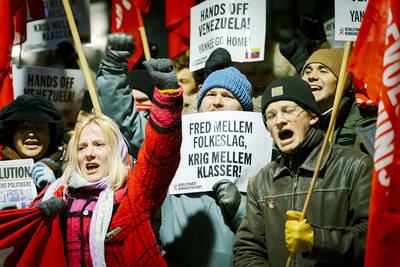Mehrdad Vakili remembers his father screaming, "Get out of the house!" as Iran's devastating earthquake began shaking the walls of the family's home. The 12-year-old boy ran but was immediately pinned by rubble.
Mehrdad was rescued. His father and younger brother were not.
"I don't want to live without them," Mehrdad said Thursday as a female relative dabbed his tears with a handkerchief at his bedside in a Kerman hospital, where he was recovering from a broken leg and severe stomach wounds.
Survivors brought to the provincial capital recounted narrow brushes with death during the Dec. 26 earthquake that struck at dawn, wiping out entire families in their homes, killing nearly 30,000 people and devastating the city of Bam.
In the flattened city, US aid workers began admitting patients to an American field hospital -- a rare contact between the nations since US-Iranian relations were broken by the seizure of the Embassy in Tehran in 1979.
Taking their first look at the damage, six American aid workers passed the mangled remains of crushed cars and people still sifting through the wreckage for their battered possessions.
Thursday marked the seventh day after the quake and was a day of mass mourning, with Iran's supreme leader holding a memorial service in Bam. Iranian Shiites traditionally observe a mourning period for a deceased relative a week after the death.
At a cemetery outside Bam where corpses have been buried in mass graves, families clustered around burial mounds, hugging and sobbing.
One mourner, Yadolah Khodabakhshzade, lost 18 family members, who were sleeping in three adjacent houses that collapsed in the quake. "It's God's will," he said haltingly.
In an effort to identify bodies, police have set up three laptop computers at the Bam cemetery that show a morbid slideshow of 400 photographs of the faces of unclaimed bodies.
A crowds of mourners gathered and watched as bloodied, dusty faces appeared on the screen one after the next -- each accompanied by an identification number. The slideshows have led to 30 positive identifications, a policeman said.
Estimates on the death toll varied. A UN report that cited government figures said the death toll by Tuesday was least 33,000. A provincial government spokesman, Asadollah Iranmanesh, said 26,500 bodies were confirmed recovered and buried in Bam or nearby towns and predicted the final toll would be between 30,000 and 40,000.
Although hopes for survivors were fading, workers said they rescued three more people -- one on Thursday and two on Wednesday. Normally, people trapped under collapsed buildings can survive three days, a mark that passed Monday morning.
Medical workers reported more good news amid the gloom as five babies were born since Tuesday -- three boys delivered in a French field hospital and two girls delivered in a Ukrainian field hospital.
At Kerman's Afzalipor Hospital, other survivors recalled their traumas in the rubble.
Hadi Pashouei was buried up to his neck by the wreckage of the Bam police station where he was on duty when the quake hit -- and remained there for three agonizing hours until he was discovered and pulled out.
"It was worse than hell," Pashouei, 19, said. "Bricks and cement piled on top of me. You want to escape, you can't move. You have pain, there's no cure."
Mehrdad, the 12-year-old, was trapped for two hours until his uncle dug him out.
"My dad was buried alive as he rushed to save us," the boy said. "Nobody was able to save the life of my dad and brother."

Indonesia yesterday began enforcing its newly ratified penal code, replacing a Dutch-era criminal law that had governed the country for more than 80 years and marking a major shift in its legal landscape. Since proclaiming independence in 1945, the Southeast Asian country had continued to operate under a colonial framework widely criticized as outdated and misaligned with Indonesia’s social values. Efforts to revise the code stalled for decades as lawmakers debated how to balance human rights, religious norms and local traditions in the world’s most populous Muslim-majority nation. The 345-page Indonesian Penal Code, known as the KUHP, was passed in 2022. It

‘DISRESPECTFUL’: Katie Miller, the wife of Trump’s most influential adviser, drew ire by posting an image of Greenland in the colors of the US flag, captioning it ‘SOON’ US President Donald Trump on Sunday doubled down on his claim that Greenland should become part of the US, despite calls by the Danish prime minister to stop “threatening” the territory. Washington’s military intervention in Venezuela has reignited fears for Greenland, which Trump has repeatedly said he wants to annex, given its strategic location in the arctic. While aboard Air Force One en route to Washington, Trump reiterated the goal. “We need Greenland from the standpoint of national security, and Denmark is not going to be able to do it,” he said in response to a reporter’s question. “We’ll worry about Greenland in

PERILOUS JOURNEY: Over just a matter of days last month, about 1,600 Afghans who were at risk of perishing due to the cold weather were rescued in the mountains Habibullah set off from his home in western Afghanistan determined to find work in Iran, only for the 15-year-old to freeze to death while walking across the mountainous frontier. “He was forced to go, to bring food for the family,” his mother, Mah Jan, said at her mud home in Ghunjan village. “We have no food to eat, we have no clothes to wear. The house in which I live has no electricity, no water. I have no proper window, nothing to burn for heating,” she added, clutching a photograph of her son. Habibullah was one of at least 18 migrants who died

Russia early yesterday bombarded Ukraine, killing two people in the Kyiv region, authorities said on the eve of a diplomatic summit in France. A nationwide siren was issued just after midnight, while Ukraine’s military said air defenses were operating in several places. In the capital, a private medical facility caught fire as a result of the Russian strikes, killing one person and wounding three others, the State Emergency Service of Kyiv said. It released images of rescuers removing people on stretchers from a gutted building. Another pre-dawn attack on the neighboring city of Fastiv killed one man in his 70s, Kyiv Governor Mykola